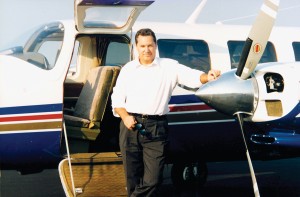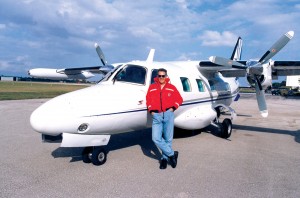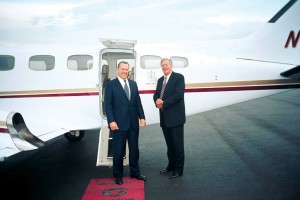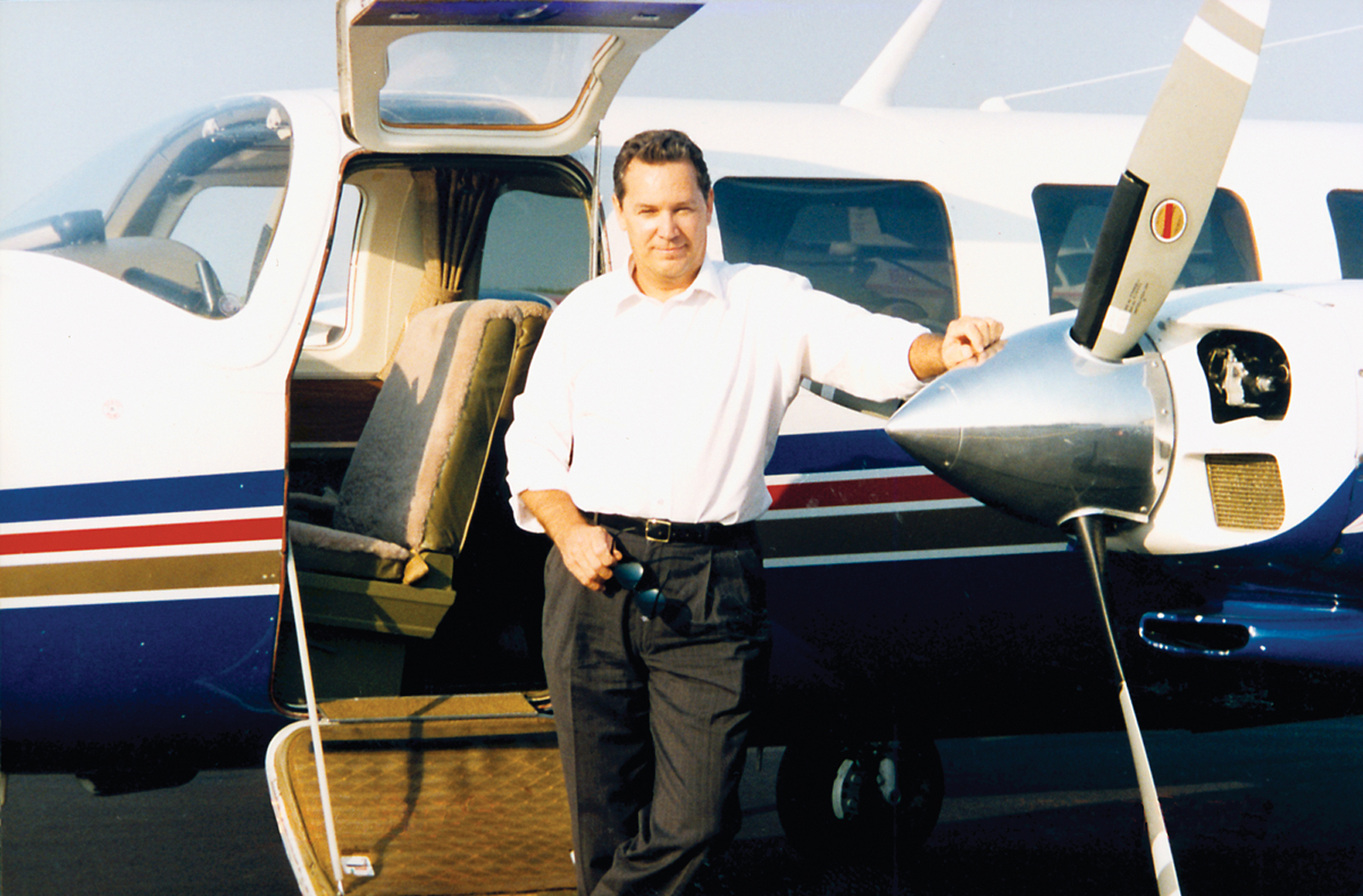By Di Freeze
When it became apparent that Jeffrey L. Rodengen would be making many talk show appearances to discuss his latest book, the pilot/author wondered if he could get away with speaking with a bag over his head. Studio execs quickly shot down that idea. It’s not that he was ashamed of “All Men are Liars: An Incomplete Guide to Relationship Trauma,” which was released in November 2005; it’s just that he wasn’t sure how the book would affect his well-earned reputation as a highly regarded industrial historian.

Jeff Rodengen’s first high-performance aircraft was this Aerostar Superstar 700P. “It was like flying a Ferrari, small wings, high speed, limited range,” he said. “It was also my most maintenance-heavy aircraft.”
This might be his first book to fall into the category of “interpersonal relationships/psychological humor,” but the best-selling author has already written more than 100 acclaimed books on the history and evolution of business, industry and technology. He was concerned about how the industry giants he’s interviewed—particularly the males—would feel when hearing that “All Men are Liars.”
“As a business author, the last thing I wanted them to think was that I thought they were all liars,” says the 56-year-old chairman and CEO of Write Stuff Enterprises.
Ironically, it was one of those industry giants who begged Rodengen to write the book and even contributed to it, but requested that his identity be withheld.
“He’s a great guy and a well-respected founder of a very large high-tech company,” Rodengen revealed. “When he asked me if I would be interested in putting this book together, my first inclination was, ‘Well, no, it sounds like I could get in trouble calling all men liars.’ But he was very convincing.”
It’s understandable why he would need to be convinced. Rodengen has earned respect by writing books such as “The Legend of Chris-Craft,” The Legend of Cessna,” The Legend of Gulfstream” and “State of the Heart.” Was there any reason to delve into personal relationships as well? Still, it was a very tempting idea—especially when Anonymous related his own problems, citing several examples.
“He’s had just about every kind of tragic and comic thing happen in relationships,” Rodengen said. “For instance, he’s a very high-tech guy who’s always experimenting with new gadgets. When he went to Europe with his girlfriend, he brought along a couple of different kinds of cell phones he was testing.
“During dinner one night, one of the phones rang. He said, ‘Well, that’s great. OK, I’ll get back to you next week.’ Probably by dessert, the other phone rang, and he said, ‘I can’t talk right now; I’ll get back to you.’ His girlfriend said, ‘Why do you have two cell phones?’ He said, ‘I’m trying each one to see which countries they’ll work in.’ She said, ‘No you aren’t. You have one for one girlfriend and one for the other!’ He said, ‘No, I don’t.’ She said, ‘Yes, you do,’ and threw down her napkin and flew home.”
Anonymous woefully admitted he had many stories like that.
“He said, ‘I’ve always gotten into trouble because women don’t believe men. They think all men are liars,'” Rodengen said.
With that statement, Rodengen realized he had a very clever title.
“I said, ‘OK, let’s call it that,'” he remembered. “So we did it. It took a lot of research, but it was a lot of fun to put together.”
Part of that fun included hiring Dave Hoover, one of the leading illustrators in America, to illustrate the book.
“He illustrates Superman and Spiderman comic books,” Rodengen said. “We asked him to put together some custom illustrations to describe scenes in which men are caught lying, or how women enable or train men to lie.”
The theme comes across clearly on the book’s cover, which shows Neanderthals sporting Pinocchio noses.
“There are provocative sections, certainly, but also, there’s light humor,” Rodengen said.
The book doesn’t include lies related only to romantic relationships. It provides a look at the “colorful variety of falsehoods” encountered daily in personal and professional lives, and explores lies in the areas of sports, advertising and entertainment. The book also explains that many lies “serve a meaningful purpose, so the chance for forgiveness remains at hand.”
Shortly after the book was released, Rodengen made appearances on talk shows such as Anderson Cooper 360, Today Show, The Early Show, The Big Idea, The View and Good Morning America. A couple of surprises thrilled him. First, “All Men are Liars” had a “benign impact” on his professional career. Second, both women and men embraced the book.
“It was fascinating to me how many people liked and appreciated it; no one—men or women—denied it,” he said.
In the book, Rodengen explains how parents set the stage for lies, for example, by telling children about the Easter Bunny and Santa Claus. Later, women continue to give men ample reasons to tell falsehoods.
“Women actually enable men to lie, either by believing or pretending to believe their outright and obvious lies,” Rodengen said. “They also train men to lie very seriously, almost from birth, by punishing them for telling the truth. The classic example, illustrated by one of the drawings in the book, is of a woman, built roughly like a Volkswagen bus, pulling on a new pair of jeans at the store. Her husband is sitting there, looking at newspapers and watching her struggle. She says, ‘Honey, do these jeans make me look fat?’ What is he supposed to say? He says, ‘No, honey, you look just like a supermodel,’ because he knows if he tells the truth, he’ll be punished for it, no doubt about it.”
Writing and promoting the book has definitely kept Rodengen busy. However, that’s not unusual for the prolific author. Rodengen has been burning the midnight oil since he first put pen to paper.
Oh, to be a surgeon–or maybe not
Rodengen has been passionate about a lot of things in his life and has written about many of those passions. Growing up in Minneapolis provided an opportunity early on to fall in love with boats. He has owned several, and one he remembers in particular was a small triple-cockpit 1929 Chris-Craft Runabout Legend, which he acquired after writing “The Legend of Chris-Craft.”
“That was a lot of fun,” he said.
When it came time to head to college, Rodengen entered Morehead State University, with the goal of being a surgeon.
“I was in a pre-med program,” he said. “I drove an ambulance in the Fargo-Morehead area. It was a neat job for an undergraduate, because you actually slept at the ambulance place.”
Rodengen recalled that he always knew he wanted to be a surgeon.
“Everyone at that time admired Christiaan Barnard, who accomplished the first heart transplant,” he said. “My dream at the time was to go to the University of Witwatersrand in Johannesburg, and study under Barnard. But, as you grow older, you decide that another eight or 12 years of college isn’t all it seemed like when you began.”
Eventually, Rodengen would do what so many writers have done over the years—live vicariously through writing about those people he admired. Rodengen’s education didn’t include only those two universities.
“In the middle, I went to the University of the Americas in Mexico City for half a year,” he said. “That was during the Olympics. I really enjoyed that.”
He says he attended that university to learn Spanish and because he was “young and foolish.” But he headed to the University of California at Riverside, after a friend told him it was a great school. He began his journey in writing, outside of normal scholastic assignments, when he was an intern at a radio station in San Bernardino, Calif.
“I started writing news copy—everything from jingles to radio commercials—and found I had a flair for putting words together,” he said.
At the age of 20, he became the assistant director of the Naval and Underseas Museum, after he responded to a recruiting notice and was interviewed in Newport, R.I. With the additional duty of museum archivist, he spent a good deal of time researching artifacts.
“I got to travel around the world, trading artifacts with different governments,” he said. “We might have a couple of Portuguese cannons, and we’d need a couple of Spanish cannons, or whatever the case might be. That was a great learning experience for me.”
Rodengen was with the museum for about a year and a half. Then, it was back to Southern California, where he would eventually write, produce and direct nearly 30 films and network television specials. He was also involved with various Las Vegas reviews and Broadway productions. After learning a little bit about radio and sound production, he opened DC Recording Studios.
“It was a modest 8-track studio, which expanded to 16 tracks and then 24,” he said. “I did some complicated album work, as well as motion picture soundtracks, radio jingles and that type of thing. I did a lot of live talent, and elements of groups, from Lou Rawls to Linda Ronstadt, to great gospel singers and country western singers and rock and roll.”
Following that, Rodengen formed a partnership with another entrepreneur and opened up a multi-image studio.
“One component was recording,” he said. “We did up to 30-projector multi-image presentations for major corporations around the world.”
AVIII morphed into a couple of other companies, including AVAmerica, before Rodengen left the communications field.

Jeff Rodengen used to keep his Citation ISP Eagle in the air 12,000 to 15,000 miles a month. It wasn’t unusual for him to drop into two or three cities in a day, and return to have dinner with his twins, who love to fly.
“Eventually the technology of that industry mushroomed so that it could be done on anyone’s desktop, and so the need for the large overhead organization to do it evaporated,” he said. “That’s basically when I left California.”
Before leaving, however, he worked with Arnold Schwarzenegger for two years.
“I did six CBS Sports Spectaculars for him,” he said. “I did everything from scripting presentations that he would give live on stage in Columbus, Ohio, to writing and directing multi-image presentations to support the programs.”
The Write Stuff
Rodengen moved across the nation to Fort Lauderdale, Fla., in the early 1980s, after taking a vacation there.
“I loved the area and the climate,” he said. “Also, I had gotten burned out. I was working 100 hours a week in California. I did that for 15 years. It was time to shift gears, so I took the opportunity to become the editor of what was then the largest outdoor magazine in Florida.”
That magazine, Southern Star, covered boating, fishing and other outdoor sports Florida had to offer. Rodengen’s job included editing, reporting and even type-setting. He also elected to do a series on America’s best boat builders.
“I thought it would be perfect for my audience profile,” he said.
Rodengen was deeply involved in researching the history of Carl Kiekhaefer, the enigmatic founder of Mercury Outboard, when he stumbled upon another interesting company history, and the opportunity to write his first book.
“When I got to Chris-Craft, I couldn’t find any information,” he said. “It just didn’t exist. So I went to Bradenton, Florida, and took a look at what Chris-Craft had in their archives, which was just about nothing. It confused me why an organization wouldn’t have its own archives.”
He finally tracked them down in a museum in Virginia.
“I went up there, and everyone I talked with kept saying, ‘A lot of people would be interested in a book on this,'” he recalled. “I took the bait and spent a couple of months on-site, researching it. Then, over the next few years, I wrote the book.”
A widely read syndicated columnist by then, Rodengen left Southern Star in 1987 to form Write Stuff. “The Legend of Chris-Craft” was published in 1988.
“Chris-Craft requested a large number of volumes for their own distribution to customers,” he recalled. “Everyone who’d buy a Chris-Craft would get a book. There was one really novel idea. Chris-Craft had a 72-foot boat at that time that cost about $1 million. We decided we’d do a leather-bound version and sell it for $1 million, and throw in the Chris-Craft free—kind of a reverse fun concept.”
Although he was excited about his first book, the experience was less than perfect.
“I delivered about 25,000 books to Chris-Craft on a Friday, and on Monday they declared bankruptcy, so I couldn’t get paid for them,” he said. “That put me in a real pickle.”
Rodengen had another 10,000 copies, which he was intent on selling.
“I went from boat show to boat show, and bookstore to bookstore, across America, in an almost desperate attempt to sell the books I had, so I could pay the debts I owed as a result of putting the book together and getting it published,” he said. “I sold them all, and paid back all the debts. Just last year, we received a check from the bankruptcy, for about $3,000. That was a shock.”
Besides launching him on his career as a historian, Chris-Craft remains one of Rodengen’s best-selling books.
“It still has the broadest appeal,” he said. “It’s probably our most favorite gift book.”
It took Rodengen seven years to write his second book, “Iron Fist: The Lives of Carl Kiekhaefer,” which told the story of the Mercury Outboard founder. The author explained why the book tells about the plural “lives” of Kiekhaefer.
“He was so enigmatic,” he said. “Everyone you talked to seemed to describe a different person. He’s probably the most interesting person ever in the American marine industry. He died just before I wrote the book, or I’m sure he would have killed me for doing it.”
Rodengen described Kiekhaefer as a “combination of Genghis Kahn and Tucker.”
“He frightened a lot of people he worked with,” he said. “He made them work on Sundays and Christmas morning and everything else, but he was a brilliant engineer and had a great instinct for marketing and product development. He would take competitive outboard motors, like Evinrude and Johnson, and hang them over big scaffolds behind his plants in Fond du Lac, Wisconsin, in the woods. He’d put two or three cords of wood underneath them, soak them in diesel oil and light them. As the engines melted and splattered into the fire, he’d have his national sales force dressed up as Indians, complete with tomahawks, dancing around the fire, chanting, ‘Kill the enemy, kill the enemy.’ These were some of the more mild moments.”
The 700-page biography climbed to 13th on the bestseller list and received two Pulitzer Prize nominations, one for American history and one for American biography.
“It’s one of my favorite books, because it’s such a comprehensive look at an individual personality,” Rodengen said.
Once he’d completed that all-consuming book, and had been able to sell his copies of Chris-Craft, Rodengen was able to think about other projects.
“I stuck to the marine industry at first, which is something I knew the most about at the time,” he said.
That knowledge led to books such as “The Legend of Mercury Marine,” “The Legend of Bertram” and “Evinrude Johnson and the Legend of OMC,” which tells the remarkable history of the world’s largest maker of outboard motors and earned Rodengen two more Pulitzer Prize nominations.
But Rodengen’s interest wasn’t limited to the marine industry. He knew numerous companies in every industry had to have colorful histories and dynamic leaders, and he decided he would tell the stories of those companies and the men and women who built them into industry legends.
Rodengen has delved into the oil and automotive industries, as well as the areas of medicine, aviation, electronics/computers, consumer products and financial services. Among the most well known companies he’s chronicled are Honeywell, Goodyear, Cessna, Gulfstream, Pfizer, Halliburton, Dr. Pepper/Seven-Up and La-Z-Boy. In each case, Rodengen showcases the unique strategies and evolution of the highly successful corporations about which he carefully chooses to write.
Rodengen returned to his early fascination for medicine when he began “State of the Heart: The Practical Guide to Your Heart and Heart Surgery,” which he wrote with the help of respected cardiothoracic surgeon Larry W. Stephenson, M.D. The book is the ultimate source of information for heart patients and their families, as well as anyone concerned with heart health. Prominent surgeons from the world’s leading cardiac care centers contributed to the book, which also includes advice from many pioneers of heart surgery, including Christiaan N. Barnard, Denton Cooley, Michael E. DeBakey, John Kirklin and C. Walton Lillehei.
“We had wonderful interviews with great people, including Boris Petrovsky, who was head of the Soviet program years ago, and whose claim to fame was sewing two heads on a dog to trace their circulatory patterns,” he said. “I took care of all the interviews, but I relied very heavily on Dr. Stephenson, one of the leading heart surgeons in the world, for his technical expertise. My staff and I arranged for the illustrations; we hired the three best medical illustrators in the world, which was fun—and expensive.”
Rodengen was pleased with the result of a few years of labor.
“It beat out the Mayo Clinic book on the heart and the Cleveland Clinic book on the heart, because it’s so well done, and so attractive, well illustrated and easy to understand,” he said. “It’s the only book the Society of Thoracic Surgeons put on their website in its entirety. They put the entire book on there for other surgeons to look at, and they refer patients to it.”
Other books regarding the medical industry followed “State of the Heart” throughout the years, including “The Yes, You Can of Invacare Corporation” and “The Legend of Pfizer.”
Under the heading of general industry, he’s covered companies such as innovative transportation giant Werner Enterprises, global manufacturer Ingersoll-Rand, engine maker Briggs & Stratton, and the National Rifle Association, whose dramatic and fascinating history is brought to light in “NRA: An American Legend.” Presently, Fort Lauderdale-based Write Stuff has many projects underway, including the history of the Chicago Mercantile Exchange and that of Kellogg, in honor of the company’s 100th anniversary.
“Kellogg is a great company—you know, Tony the Tiger; Snap, Crackle, Pop; the Toucan,” Rodengen said.
Rodengen is also working on the third edition of “The Legend of Cessna,” as well as the fifth edition of the “Legend of Chris-Craft” and the second edition of “The Legend of Gulfstream.”

Jeff Rodengen loved his Mitsubishi long-body G-Model. It was rugged, low maintenance, and a real load hauler, but had a limited range, only about 1,100 NM. “If you fly it by the book, I think it’s one of the safest aircraft around.”
“Companies change,” he explained. “Since we did the book on Cessna, I think they’ve come out with something like seven new models, and some are completely new markets for them. There have been great changes in avionics for just about every aircraft, totally new designs. The same is true for Gulfstream; they’ve made great acquisitions. They’ve come out with eight or nine new aircraft since we did the last book. It always requires two or three or four new chapters. There are new people, products, manufacturing facilities, customers. There are a lot of new stories to tell.”
Rodengen encourages companies to approach Write Stuff regarding worthy subjects for corporate histories, but says those companies must meet certain criteria.
“We turn down more companies than we write about,” he said. “A company has to be large enough to have a lot of built-in audiences. It has to be stable enough to be a world-class organization. It has to have strong ethics and good values, a good mission and a good culture, or we won’t write about them. We don’t charge anything for what we do, so we’re allowed to be a little selective. There are big companies that are real tough, rolling up their industries, but they just don’t have the right stuff for the Write Stuff.”
Rodengen describes the Write Stuff’s books as “comprehensive history cleverly disguised as coffee table books.”
“I’ve done the six hundred and seven hundred page biographies that are six by nine, and weigh four pounds, and they’re good books,” he said. “People read them from cover to cover, put them up on the shelf, and no one ever sees them again. But you can take that same information, illustrate it heavily and build in lots of artistic devices to keep the reader interested—things like personality, industry milestone and technological sidebars, and timelines and devices like that. Then, the reader will be able to browse through the book and get hooked on some of these features, and then maybe read a chapter, flip around to another place, and so forth. If they don’t read the whole book, they’ll get the message. They’ll get the overarching opinion of the company I’ve been trying to present. Also, the book will get circulated more and left out on coffee tables. Many more people will see it than a regular six by nine trade book with no illustrations.”
It’s remarkable to see everything Rodengen has accomplished, but by no means has he done it alone. He has a team of 14 at corporate headquarters.
“At any given time, I have a lot of research assistants in the field,” he said. “Today, I have 29, in major cities around the world. They do the principle research for me. They’ll go through the data archives, as well as the pictorial archives of an organization, and they’ll help to select the images that we need to illustrate the text, and they’ll help to identify the people and the subject that’s going on in the photo as well.”
Rodengen has had about 20 best-selling books. However, that has never been his principle goal.
“Many of the subjects of our books are household names—Mercury, Cessna, Stanley, La-Z-Boy, Chris-Craft, Honeywell, Goodyear—but many others are not,” Rodengen said. “The ones that aren’t, though, are really household names in their industry—Noble Drilling, Nucor Corporation, Shea or Trinity Industries. These organizations are the absolute leaders of their industries, and multi-multi-billion dollar firms, but they’re not household names. But they’ve made such an enormous contribution to their industry and to American enterprise that they just can’t be ignored.”
The subjects of the books make the Write Stuff staff “careful marketers.”
“We have to be good rifle marketers in order to support works like that,” Rodengen said. “We have good wholesale relations with B. Dalton, Crown, Barnes and Noble, Amazon, Booksamillion, and the usual distribution suspects. We’ll concentrate on the areas where those organizations have a corporate presence. For example, Ingersoll-Rand had 50,000 employees spread out in a dozen countries, and lots of manufacturing sites in North America, so we began by developing relationships with the bookstores in every one of those cities, where they have their biggest corporate presence. We fanned out from there. Every book has a market; you just have to carefully explore it and then execute a good distribution plan for it.
Getting from here to there

Jeff Rodengen’s current ride is his Cessna Conquest II with Dash-10 engines. “When I traded in my Citation for the Conquest II, my expenses were almost cut in half, but I only lost 30 kts, and picked up two seats,” he said.
Because he travels extensively, it’s a definite bonus that Rodengen developed a passion for flying when he was younger. Both his parents were pilots.
“My dad was a gunner aboard B-24s in World War II,” he said. “When he got back from the war he started to fly. Eventually my mom picked it up. She was very active in the 99s.”
He recalls that the first time he flew was in his father’s Aeronca Champ, at the age of 9.
“That was a lot of fun. I think he bought the plane for $700. Looking back, I think he paid too much for it,” he laughed.
Since getting his private pilot’s license in the early 1970s, Rodengen has logged 5,000 hours; 3,500 of those hours are jet time. He has commercial pilot, land and sea, and multi land and sea commercial ratings, as well as a 100-ton Coast Guard license.
“As a ship’s captain, I have more than 20,000 miles at sea,” he said.
He’s owned several aircraft and loved them all.
“I’ve had an eclectic list of aircraft that I’ve fallen in love with,” he said. “My first was a Beech 18, which is that twin-tailed, twin-engine Beechcraft. Mine was built in the 1950s. It had a tall cabin and it was wonderfully equipped. It had walnut tables and great leather seats. It was a tail dragger—an awfully big tail dragger. It was a great airplane. I used to fly executives and coworkers out to Catalina Island, off of southern California, for buffalo burgers, and I would fly executives everywhere, from Oregon to Los Alamos’ secret facilities for work.”
He said his next aircraft, an Aerostar Superstar 700, was quite a change.
“I really loved it,” he said. “It’s a tiny little plane with no wings, but very fast and very maneuverable. I always felt it was like driving a Maserati.”
Rodengen flew that aircraft for several years, before making the move to turbine.
“My first turbine aircraft was a Mitsubishi MU-2, the long body,” he said. “I flew it all over the country, the Caribbean and Central America. I enjoyed it tremendously. It has an undeserved bad reputation. It’s a wonderful aircraft for the careful pilot to fly, in all weather conditions. It’s built like a Sherman tank.”
He later moved to pure jet.
“My first one was a Citation I/SP, with a full Eagle modification by Sierra Industries,” he said. “The Eagle modification provided for longer range and faster speeds and higher altitude. I needed all of those, particularly being based in south Florida. With an unmodified Citation I, you would barely get out of Florida before you had to refuel again. I could at least get 1,200 or 1,300 nautical miles with it, depending on the wind. I had to go through the single pilot courses; that’s a real privilege for a pilot, to fly equipment like that alone. I enjoyed that a lot.”
Rodengen loved flying a jet for many reasons.
“With all of my aircraft, I’ve kept a schedule of between 12,000 and 15,000 miles a month,” he said. “I liked the jet because I could go to two or three cities in a day and be home in time to have dinner back in Florida. I have 12-year-old twins. As they were growing up, I was eager to get home to see them. But, like any good business executive, I was analyzing my costs and my missions and everything else. I realized I needed longer range in order to be efficient, so I wasn’t making so many fuel stops. I might go to San Francisco, and to Vancouver, Toronto and New York. I was really on the move, and having to make a lot a fuel stops every day isn’t practical.”
He started looking around for a long-range aircraft that would be economical to fly, as well as comfortable, and decided on a turboprop.
“I settled on the Cessna Conquest II, the 441 model,” he said. “It has a range of 2,200 nautical miles, which is enormous. It was only 30 knots slower than the Citation, and it can seat up to 11 people, so I picked up a few seats. For all that, it cost roughly half as much to operate. The little boy in me pouted when I traded in the Citation, and bought the Conquest, because the Citation is such a sexy looking aircraft. But the CEO in me was very proud as the results came in: maintenance, stage length, cost per mile, all of those things that you have to consider with aircraft ownership.”
Rodengen has a deposit on another Cessna business jet, the company’s Citation Mustang.
“I was one of the first people to make a deposit on the Mustang,” he said. “It was during the announcement that Cessna made at NBAA a few years ago. I stepped right up to the plate, because it’s impossible to beat Cessna quality and integrity. As their historian, I know that anything they’ve undertaken, they’ve done absolutely first-rate. Their products are always safe and have high quality and good residual value.”
He’d also love to become familiar with the cockpit of Aviation Technology Group’s very light jet, the Javelin, taking shape under the leadership of ATG Chairman George Bye and President Charlie Johnson.

Jeff Rodengen has flown many celebrities and high-profile politicians around in his many aircraft, including then House Majority Leader Dick Armey, shown here boarding Rodengen’s Conquest II.
“I think the Javelin would be almost any pilot’s dream plane,” he said. “Who wouldn’t want to be able to climb at 9,000 feet a minute and to travel at about .72 Mach, at 40,000 feet, in an aircraft that looks like an F-16? It’s a wonderful aircraft. Johnson and company in Colorado are doing a great job of taking it from the drawing board into hangars. And the other thing is, 95 percent of the time, I fly alone, even though I have a large cabin. So, the best news about the Javelin is, they say it can take two sets of golf clubs. There you have it.”
For information on all of Jeffrey Rodengen’s books, visit [http://www.writestuffbooks.com].











